Business and Business Environment: ALDI Analysis Report
VerifiedAdded on 2020/12/09
|14
|3406
|222
Report
AI Summary
This report provides a comprehensive analysis of ALDI's business environment. It begins by exploring different types of business concerns and their legal structures, with a focus on private, public, and voluntary organizations. The report then examines the size and scope of various organizational types, using ALDI as a case study. It delves into the relationships between different organizational functions, such as marketing, human resources, and finance, and how these functions contribute to achieving organizational objectives. Furthermore, the report investigates the positive and negative impacts of macro-environmental factors, including political, economic, social, technological, and environmental factors, using a PESTLE analysis. Finally, it conducts an internal and external analysis of ALDI to identify its strengths and weaknesses, and discusses the interrelation of these elements with the macro-environment.
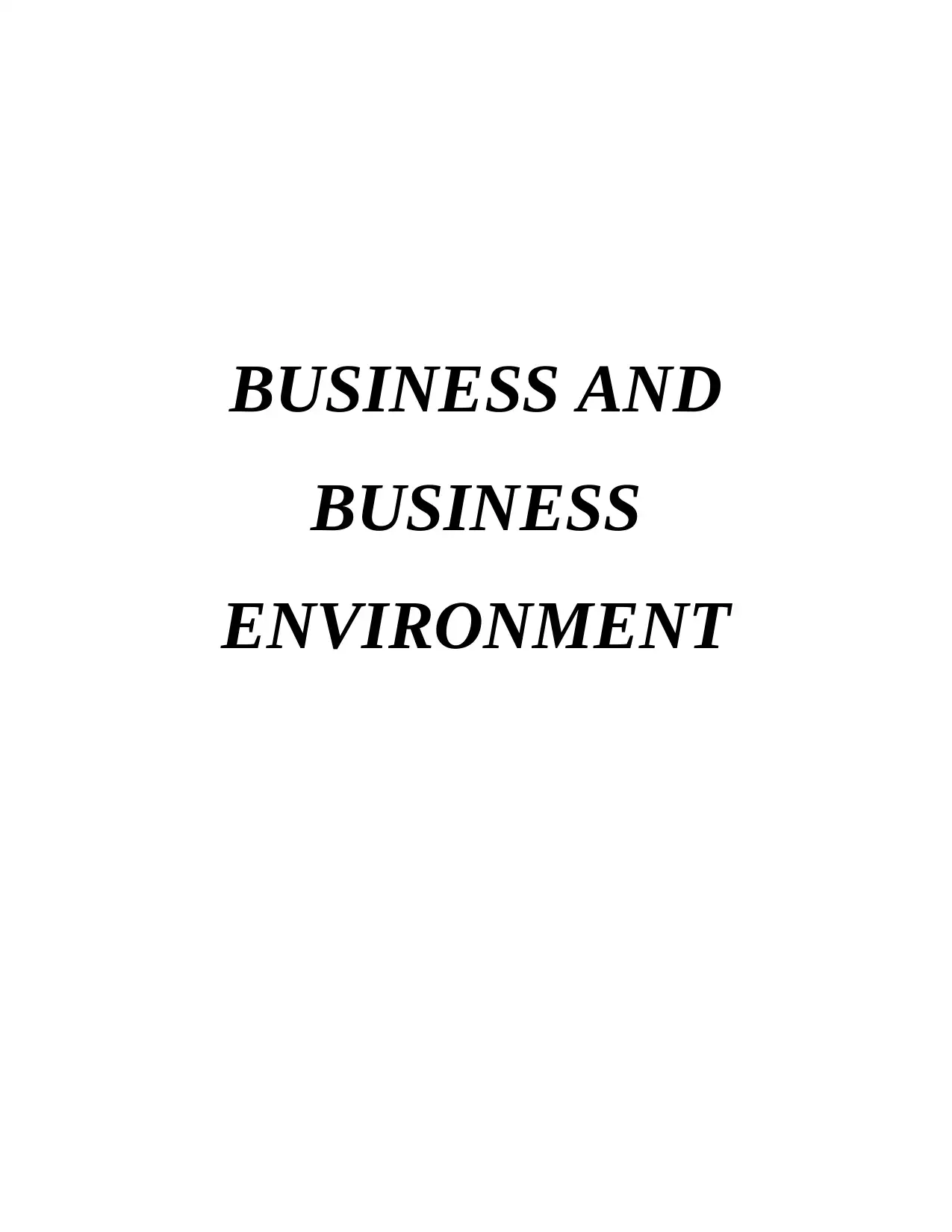
BUSINESS AND
BUSINESS
ENVIRONMENT
BUSINESS
ENVIRONMENT
Paraphrase This Document
Need a fresh take? Get an instant paraphrase of this document with our AI Paraphraser
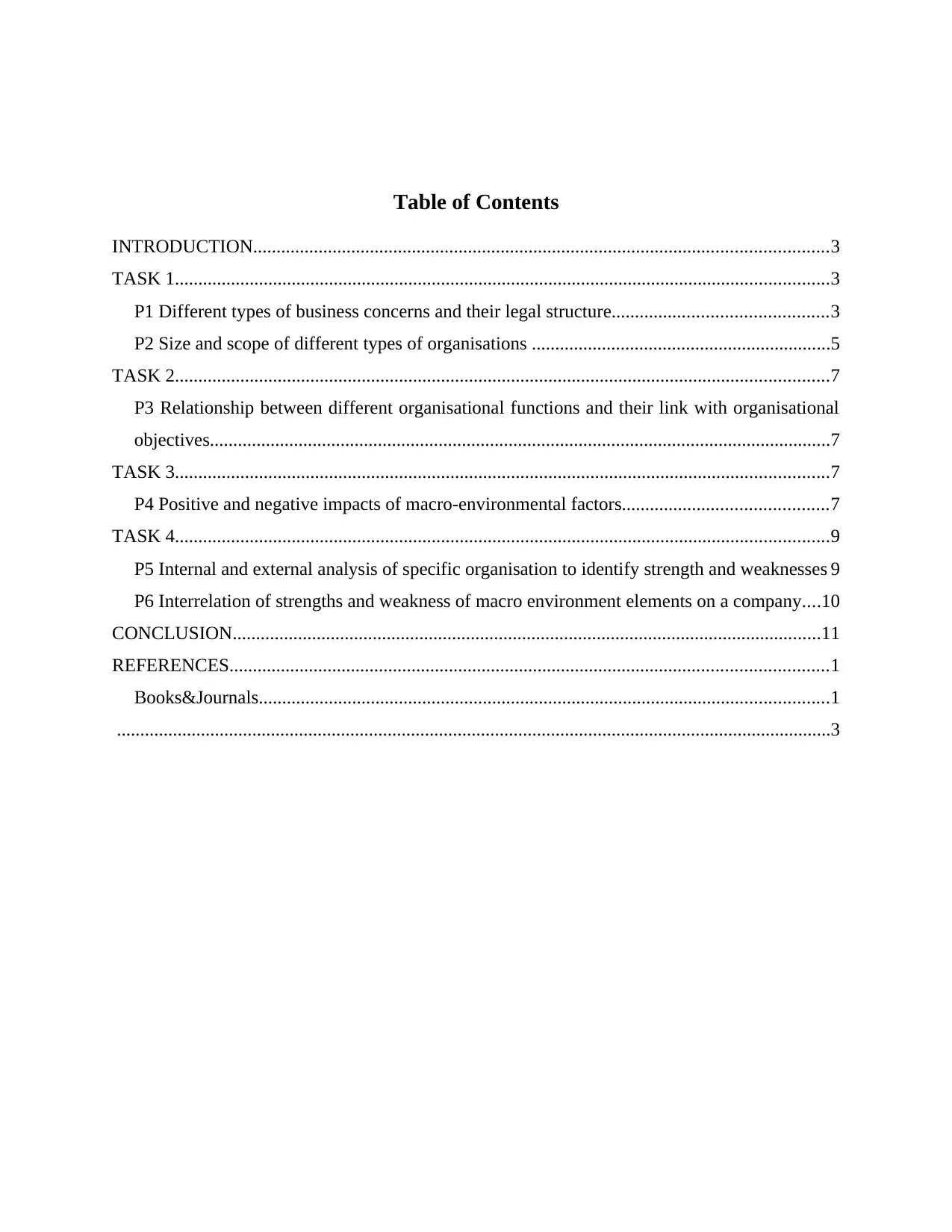
Table of Contents
INTRODUCTION...........................................................................................................................3
TASK 1............................................................................................................................................3
P1 Different types of business concerns and their legal structure..............................................3
P2 Size and scope of different types of organisations ................................................................5
TASK 2............................................................................................................................................7
P3 Relationship between different organisational functions and their link with organisational
objectives.....................................................................................................................................7
TASK 3............................................................................................................................................7
P4 Positive and negative impacts of macro-environmental factors............................................7
TASK 4............................................................................................................................................9
P5 Internal and external analysis of specific organisation to identify strength and weaknesses 9
P6 Interrelation of strengths and weakness of macro environment elements on a company....10
CONCLUSION..............................................................................................................................11
REFERENCES................................................................................................................................1
Books&Journals..........................................................................................................................1
.........................................................................................................................................................3
INTRODUCTION...........................................................................................................................3
TASK 1............................................................................................................................................3
P1 Different types of business concerns and their legal structure..............................................3
P2 Size and scope of different types of organisations ................................................................5
TASK 2............................................................................................................................................7
P3 Relationship between different organisational functions and their link with organisational
objectives.....................................................................................................................................7
TASK 3............................................................................................................................................7
P4 Positive and negative impacts of macro-environmental factors............................................7
TASK 4............................................................................................................................................9
P5 Internal and external analysis of specific organisation to identify strength and weaknesses 9
P6 Interrelation of strengths and weakness of macro environment elements on a company....10
CONCLUSION..............................................................................................................................11
REFERENCES................................................................................................................................1
Books&Journals..........................................................................................................................1
.........................................................................................................................................................3
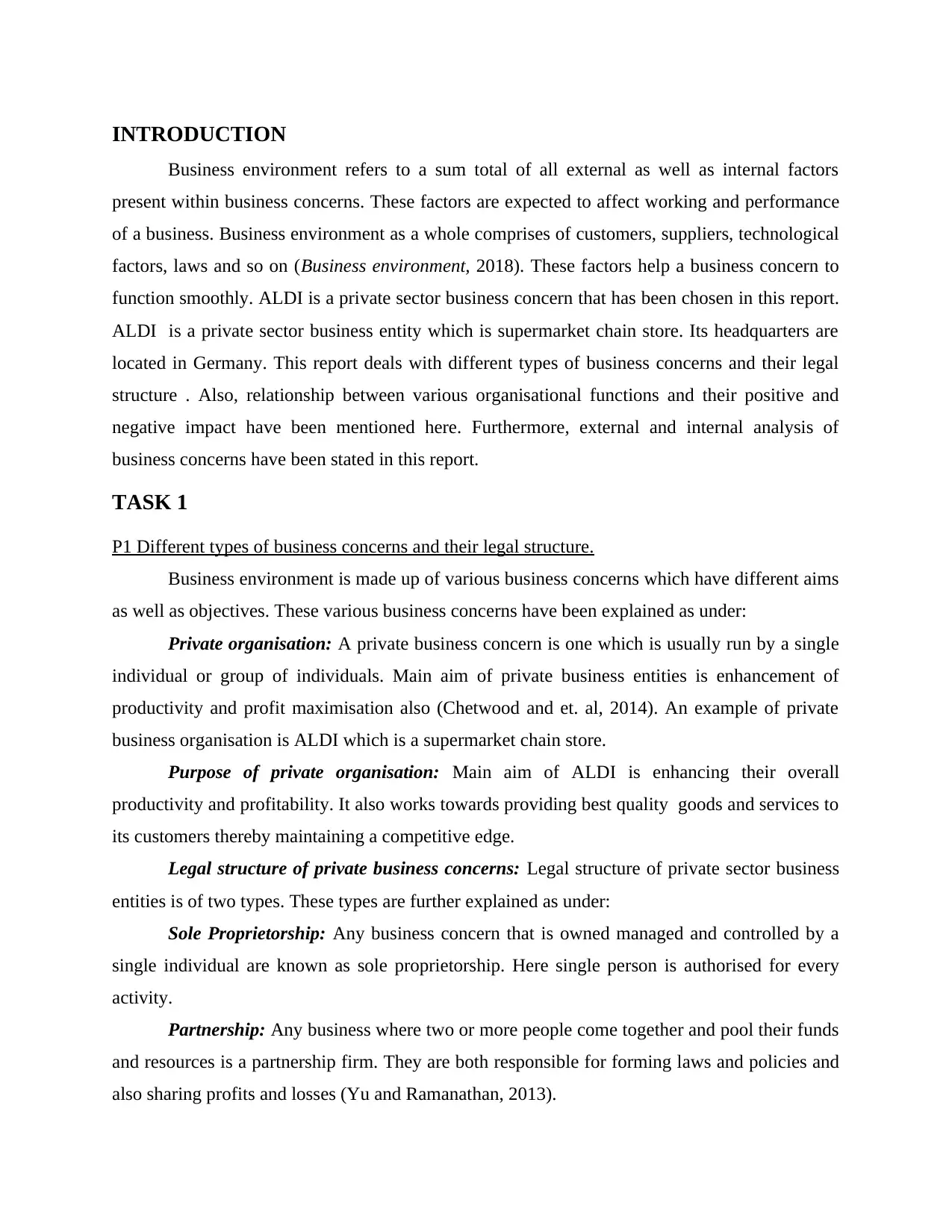
INTRODUCTION
Business environment refers to a sum total of all external as well as internal factors
present within business concerns. These factors are expected to affect working and performance
of a business. Business environment as a whole comprises of customers, suppliers, technological
factors, laws and so on (Business environment, 2018). These factors help a business concern to
function smoothly. ALDI is a private sector business concern that has been chosen in this report.
ALDI is a private sector business entity which is supermarket chain store. Its headquarters are
located in Germany. This report deals with different types of business concerns and their legal
structure . Also, relationship between various organisational functions and their positive and
negative impact have been mentioned here. Furthermore, external and internal analysis of
business concerns have been stated in this report.
TASK 1
P1 Different types of business concerns and their legal structure.
Business environment is made up of various business concerns which have different aims
as well as objectives. These various business concerns have been explained as under:
Private organisation: A private business concern is one which is usually run by a single
individual or group of individuals. Main aim of private business entities is enhancement of
productivity and profit maximisation also (Chetwood and et. al, 2014). An example of private
business organisation is ALDI which is a supermarket chain store.
Purpose of private organisation: Main aim of ALDI is enhancing their overall
productivity and profitability. It also works towards providing best quality goods and services to
its customers thereby maintaining a competitive edge.
Legal structure of private business concerns: Legal structure of private sector business
entities is of two types. These types are further explained as under:
Sole Proprietorship: Any business concern that is owned managed and controlled by a
single individual are known as sole proprietorship. Here single person is authorised for every
activity.
Partnership: Any business where two or more people come together and pool their funds
and resources is a partnership firm. They are both responsible for forming laws and policies and
also sharing profits and losses (Yu and Ramanathan, 2013).
Business environment refers to a sum total of all external as well as internal factors
present within business concerns. These factors are expected to affect working and performance
of a business. Business environment as a whole comprises of customers, suppliers, technological
factors, laws and so on (Business environment, 2018). These factors help a business concern to
function smoothly. ALDI is a private sector business concern that has been chosen in this report.
ALDI is a private sector business entity which is supermarket chain store. Its headquarters are
located in Germany. This report deals with different types of business concerns and their legal
structure . Also, relationship between various organisational functions and their positive and
negative impact have been mentioned here. Furthermore, external and internal analysis of
business concerns have been stated in this report.
TASK 1
P1 Different types of business concerns and their legal structure.
Business environment is made up of various business concerns which have different aims
as well as objectives. These various business concerns have been explained as under:
Private organisation: A private business concern is one which is usually run by a single
individual or group of individuals. Main aim of private business entities is enhancement of
productivity and profit maximisation also (Chetwood and et. al, 2014). An example of private
business organisation is ALDI which is a supermarket chain store.
Purpose of private organisation: Main aim of ALDI is enhancing their overall
productivity and profitability. It also works towards providing best quality goods and services to
its customers thereby maintaining a competitive edge.
Legal structure of private business concerns: Legal structure of private sector business
entities is of two types. These types are further explained as under:
Sole Proprietorship: Any business concern that is owned managed and controlled by a
single individual are known as sole proprietorship. Here single person is authorised for every
activity.
Partnership: Any business where two or more people come together and pool their funds
and resources is a partnership firm. They are both responsible for forming laws and policies and
also sharing profits and losses (Yu and Ramanathan, 2013).
⊘ This is a preview!⊘
Do you want full access?
Subscribe today to unlock all pages.

Trusted by 1+ million students worldwide
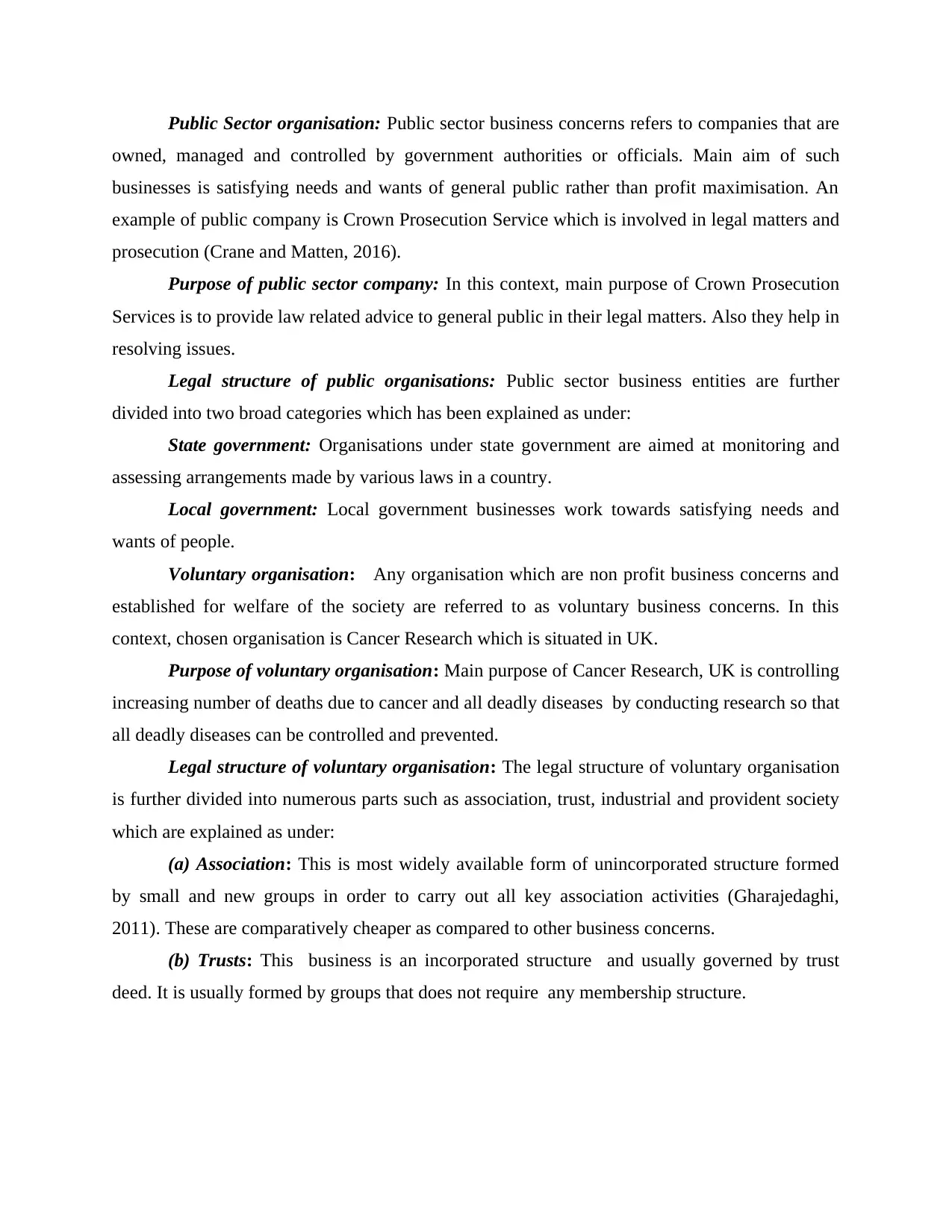
Public Sector organisation: Public sector business concerns refers to companies that are
owned, managed and controlled by government authorities or officials. Main aim of such
businesses is satisfying needs and wants of general public rather than profit maximisation. An
example of public company is Crown Prosecution Service which is involved in legal matters and
prosecution (Crane and Matten, 2016).
Purpose of public sector company: In this context, main purpose of Crown Prosecution
Services is to provide law related advice to general public in their legal matters. Also they help in
resolving issues.
Legal structure of public organisations: Public sector business entities are further
divided into two broad categories which has been explained as under:
State government: Organisations under state government are aimed at monitoring and
assessing arrangements made by various laws in a country.
Local government: Local government businesses work towards satisfying needs and
wants of people.
Voluntary organisation: Any organisation which are non profit business concerns and
established for welfare of the society are referred to as voluntary business concerns. In this
context, chosen organisation is Cancer Research which is situated in UK.
Purpose of voluntary organisation: Main purpose of Cancer Research, UK is controlling
increasing number of deaths due to cancer and all deadly diseases by conducting research so that
all deadly diseases can be controlled and prevented.
Legal structure of voluntary organisation: The legal structure of voluntary organisation
is further divided into numerous parts such as association, trust, industrial and provident society
which are explained as under:
(a) Association: This is most widely available form of unincorporated structure formed
by small and new groups in order to carry out all key association activities (Gharajedaghi,
2011). These are comparatively cheaper as compared to other business concerns.
(b) Trusts: This business is an incorporated structure and usually governed by trust
deed. It is usually formed by groups that does not require any membership structure.
owned, managed and controlled by government authorities or officials. Main aim of such
businesses is satisfying needs and wants of general public rather than profit maximisation. An
example of public company is Crown Prosecution Service which is involved in legal matters and
prosecution (Crane and Matten, 2016).
Purpose of public sector company: In this context, main purpose of Crown Prosecution
Services is to provide law related advice to general public in their legal matters. Also they help in
resolving issues.
Legal structure of public organisations: Public sector business entities are further
divided into two broad categories which has been explained as under:
State government: Organisations under state government are aimed at monitoring and
assessing arrangements made by various laws in a country.
Local government: Local government businesses work towards satisfying needs and
wants of people.
Voluntary organisation: Any organisation which are non profit business concerns and
established for welfare of the society are referred to as voluntary business concerns. In this
context, chosen organisation is Cancer Research which is situated in UK.
Purpose of voluntary organisation: Main purpose of Cancer Research, UK is controlling
increasing number of deaths due to cancer and all deadly diseases by conducting research so that
all deadly diseases can be controlled and prevented.
Legal structure of voluntary organisation: The legal structure of voluntary organisation
is further divided into numerous parts such as association, trust, industrial and provident society
which are explained as under:
(a) Association: This is most widely available form of unincorporated structure formed
by small and new groups in order to carry out all key association activities (Gharajedaghi,
2011). These are comparatively cheaper as compared to other business concerns.
(b) Trusts: This business is an incorporated structure and usually governed by trust
deed. It is usually formed by groups that does not require any membership structure.
Paraphrase This Document
Need a fresh take? Get an instant paraphrase of this document with our AI Paraphraser
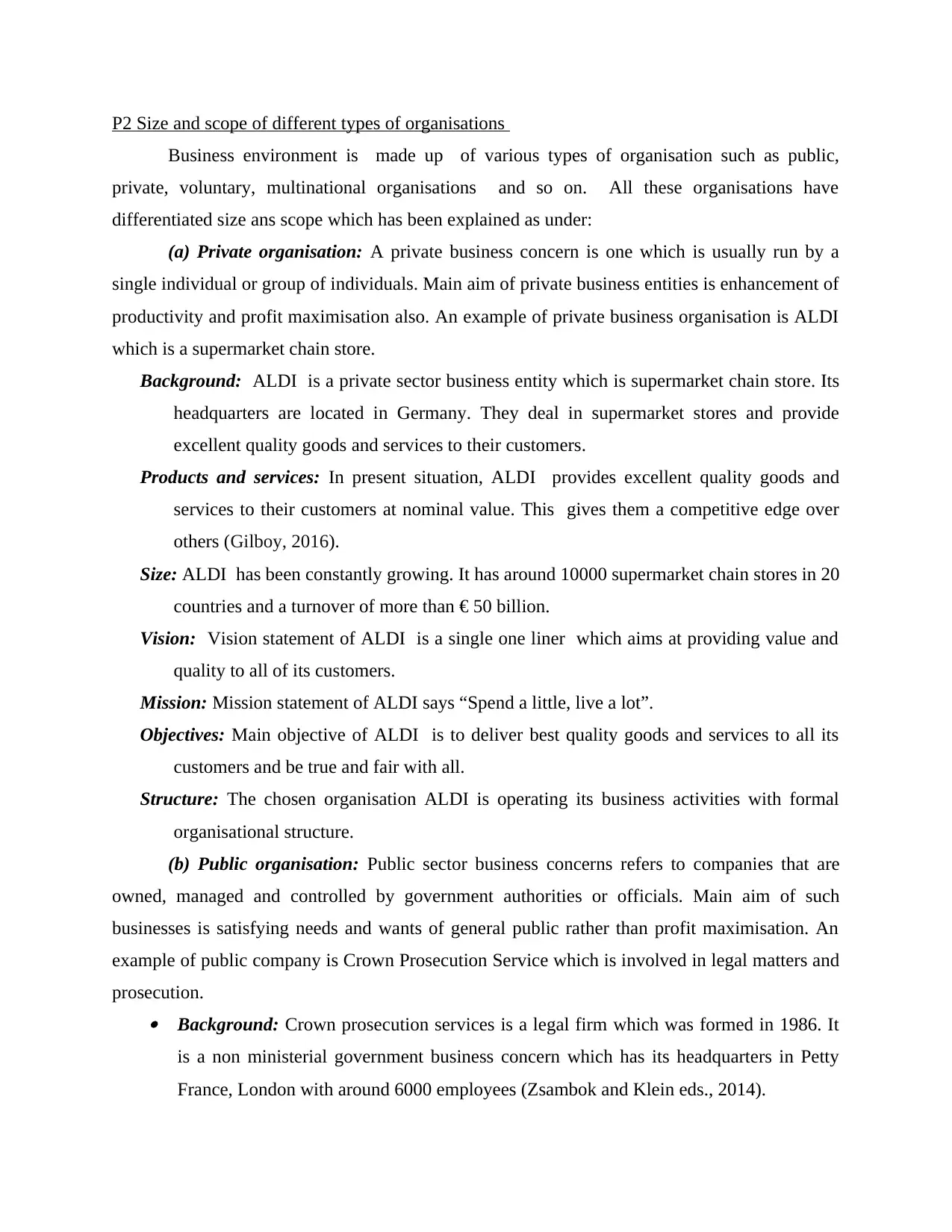
P2 Size and scope of different types of organisations
Business environment is made up of various types of organisation such as public,
private, voluntary, multinational organisations and so on. All these organisations have
differentiated size ans scope which has been explained as under:
(a) Private organisation: A private business concern is one which is usually run by a
single individual or group of individuals. Main aim of private business entities is enhancement of
productivity and profit maximisation also. An example of private business organisation is ALDI
which is a supermarket chain store.
Background: ALDI is a private sector business entity which is supermarket chain store. Its
headquarters are located in Germany. They deal in supermarket stores and provide
excellent quality goods and services to their customers.
Products and services: In present situation, ALDI provides excellent quality goods and
services to their customers at nominal value. This gives them a competitive edge over
others (Gilboy, 2016).
Size: ALDI has been constantly growing. It has around 10000 supermarket chain stores in 20
countries and a turnover of more than € 50 billion.
Vision: Vision statement of ALDI is a single one liner which aims at providing value and
quality to all of its customers.
Mission: Mission statement of ALDI says “Spend a little, live a lot”.
Objectives: Main objective of ALDI is to deliver best quality goods and services to all its
customers and be true and fair with all.
Structure: The chosen organisation ALDI is operating its business activities with formal
organisational structure.
(b) Public organisation: Public sector business concerns refers to companies that are
owned, managed and controlled by government authorities or officials. Main aim of such
businesses is satisfying needs and wants of general public rather than profit maximisation. An
example of public company is Crown Prosecution Service which is involved in legal matters and
prosecution. Background: Crown prosecution services is a legal firm which was formed in 1986. It
is a non ministerial government business concern which has its headquarters in Petty
France, London with around 6000 employees (Zsambok and Klein eds., 2014).
Business environment is made up of various types of organisation such as public,
private, voluntary, multinational organisations and so on. All these organisations have
differentiated size ans scope which has been explained as under:
(a) Private organisation: A private business concern is one which is usually run by a
single individual or group of individuals. Main aim of private business entities is enhancement of
productivity and profit maximisation also. An example of private business organisation is ALDI
which is a supermarket chain store.
Background: ALDI is a private sector business entity which is supermarket chain store. Its
headquarters are located in Germany. They deal in supermarket stores and provide
excellent quality goods and services to their customers.
Products and services: In present situation, ALDI provides excellent quality goods and
services to their customers at nominal value. This gives them a competitive edge over
others (Gilboy, 2016).
Size: ALDI has been constantly growing. It has around 10000 supermarket chain stores in 20
countries and a turnover of more than € 50 billion.
Vision: Vision statement of ALDI is a single one liner which aims at providing value and
quality to all of its customers.
Mission: Mission statement of ALDI says “Spend a little, live a lot”.
Objectives: Main objective of ALDI is to deliver best quality goods and services to all its
customers and be true and fair with all.
Structure: The chosen organisation ALDI is operating its business activities with formal
organisational structure.
(b) Public organisation: Public sector business concerns refers to companies that are
owned, managed and controlled by government authorities or officials. Main aim of such
businesses is satisfying needs and wants of general public rather than profit maximisation. An
example of public company is Crown Prosecution Service which is involved in legal matters and
prosecution. Background: Crown prosecution services is a legal firm which was formed in 1986. It
is a non ministerial government business concern which has its headquarters in Petty
France, London with around 6000 employees (Zsambok and Klein eds., 2014).
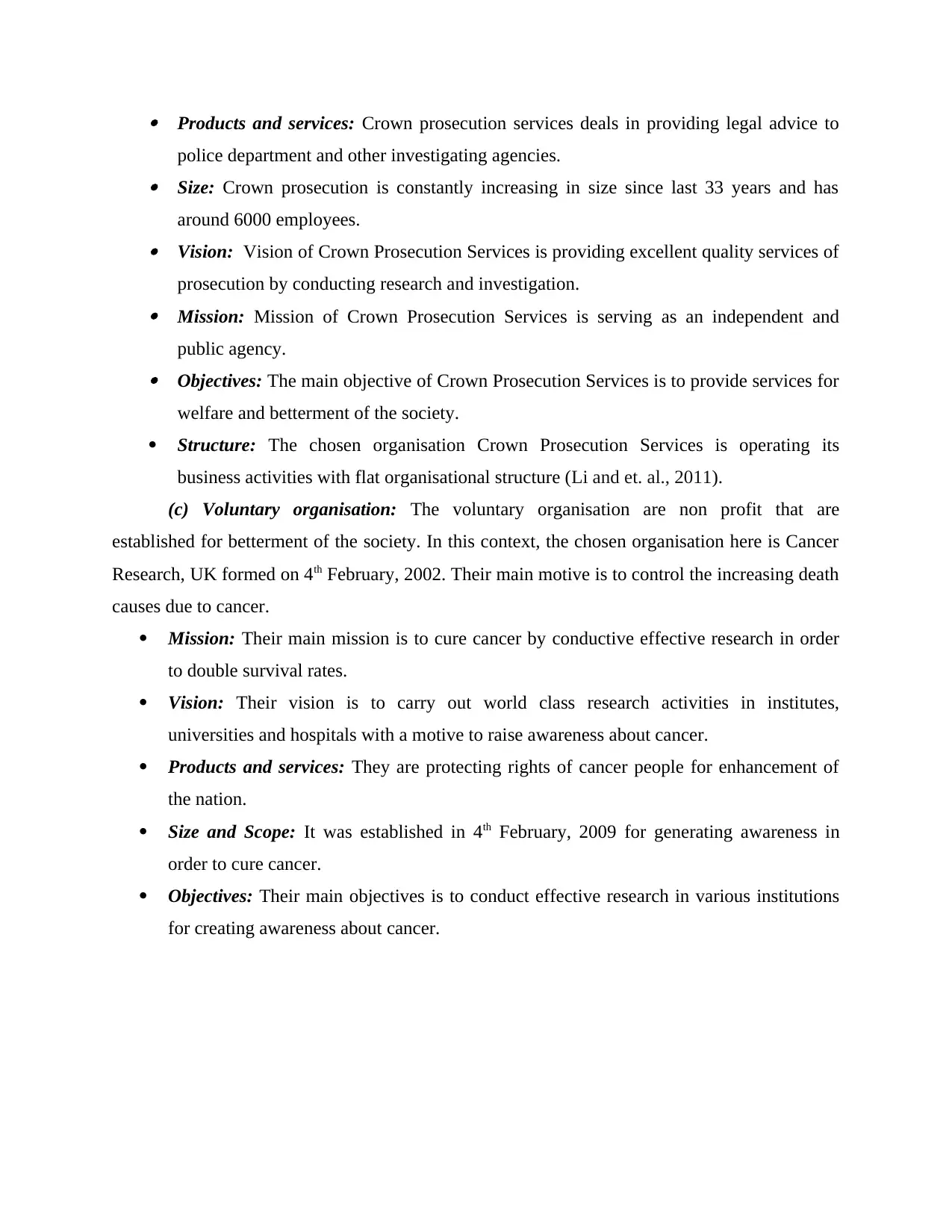
Products and services: Crown prosecution services deals in providing legal advice to
police department and other investigating agencies. Size: Crown prosecution is constantly increasing in size since last 33 years and has
around 6000 employees. Vision: Vision of Crown Prosecution Services is providing excellent quality services of
prosecution by conducting research and investigation. Mission: Mission of Crown Prosecution Services is serving as an independent and
public agency. Objectives: The main objective of Crown Prosecution Services is to provide services for
welfare and betterment of the society.
Structure: The chosen organisation Crown Prosecution Services is operating its
business activities with flat organisational structure (Li and et. al., 2011).
(c) Voluntary organisation: The voluntary organisation are non profit that are
established for betterment of the society. In this context, the chosen organisation here is Cancer
Research, UK formed on 4th February, 2002. Their main motive is to control the increasing death
causes due to cancer.
Mission: Their main mission is to cure cancer by conductive effective research in order
to double survival rates.
Vision: Their vision is to carry out world class research activities in institutes,
universities and hospitals with a motive to raise awareness about cancer.
Products and services: They are protecting rights of cancer people for enhancement of
the nation.
Size and Scope: It was established in 4th February, 2009 for generating awareness in
order to cure cancer.
Objectives: Their main objectives is to conduct effective research in various institutions
for creating awareness about cancer.
police department and other investigating agencies. Size: Crown prosecution is constantly increasing in size since last 33 years and has
around 6000 employees. Vision: Vision of Crown Prosecution Services is providing excellent quality services of
prosecution by conducting research and investigation. Mission: Mission of Crown Prosecution Services is serving as an independent and
public agency. Objectives: The main objective of Crown Prosecution Services is to provide services for
welfare and betterment of the society.
Structure: The chosen organisation Crown Prosecution Services is operating its
business activities with flat organisational structure (Li and et. al., 2011).
(c) Voluntary organisation: The voluntary organisation are non profit that are
established for betterment of the society. In this context, the chosen organisation here is Cancer
Research, UK formed on 4th February, 2002. Their main motive is to control the increasing death
causes due to cancer.
Mission: Their main mission is to cure cancer by conductive effective research in order
to double survival rates.
Vision: Their vision is to carry out world class research activities in institutes,
universities and hospitals with a motive to raise awareness about cancer.
Products and services: They are protecting rights of cancer people for enhancement of
the nation.
Size and Scope: It was established in 4th February, 2009 for generating awareness in
order to cure cancer.
Objectives: Their main objectives is to conduct effective research in various institutions
for creating awareness about cancer.
⊘ This is a preview!⊘
Do you want full access?
Subscribe today to unlock all pages.

Trusted by 1+ million students worldwide
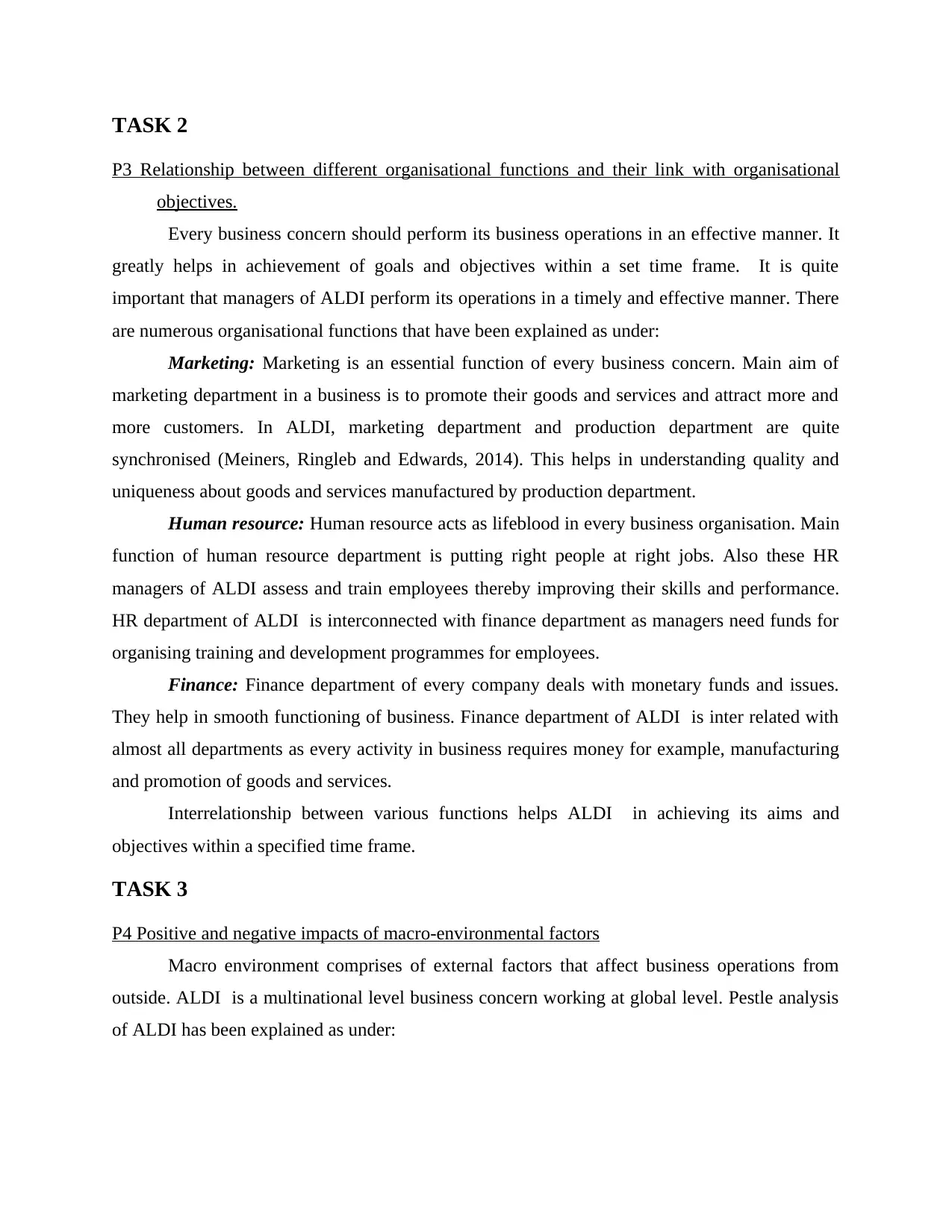
TASK 2
P3 Relationship between different organisational functions and their link with organisational
objectives.
Every business concern should perform its business operations in an effective manner. It
greatly helps in achievement of goals and objectives within a set time frame. It is quite
important that managers of ALDI perform its operations in a timely and effective manner. There
are numerous organisational functions that have been explained as under:
Marketing: Marketing is an essential function of every business concern. Main aim of
marketing department in a business is to promote their goods and services and attract more and
more customers. In ALDI, marketing department and production department are quite
synchronised (Meiners, Ringleb and Edwards, 2014). This helps in understanding quality and
uniqueness about goods and services manufactured by production department.
Human resource: Human resource acts as lifeblood in every business organisation. Main
function of human resource department is putting right people at right jobs. Also these HR
managers of ALDI assess and train employees thereby improving their skills and performance.
HR department of ALDI is interconnected with finance department as managers need funds for
organising training and development programmes for employees.
Finance: Finance department of every company deals with monetary funds and issues.
They help in smooth functioning of business. Finance department of ALDI is inter related with
almost all departments as every activity in business requires money for example, manufacturing
and promotion of goods and services.
Interrelationship between various functions helps ALDI in achieving its aims and
objectives within a specified time frame.
TASK 3
P4 Positive and negative impacts of macro-environmental factors
Macro environment comprises of external factors that affect business operations from
outside. ALDI is a multinational level business concern working at global level. Pestle analysis
of ALDI has been explained as under:
P3 Relationship between different organisational functions and their link with organisational
objectives.
Every business concern should perform its business operations in an effective manner. It
greatly helps in achievement of goals and objectives within a set time frame. It is quite
important that managers of ALDI perform its operations in a timely and effective manner. There
are numerous organisational functions that have been explained as under:
Marketing: Marketing is an essential function of every business concern. Main aim of
marketing department in a business is to promote their goods and services and attract more and
more customers. In ALDI, marketing department and production department are quite
synchronised (Meiners, Ringleb and Edwards, 2014). This helps in understanding quality and
uniqueness about goods and services manufactured by production department.
Human resource: Human resource acts as lifeblood in every business organisation. Main
function of human resource department is putting right people at right jobs. Also these HR
managers of ALDI assess and train employees thereby improving their skills and performance.
HR department of ALDI is interconnected with finance department as managers need funds for
organising training and development programmes for employees.
Finance: Finance department of every company deals with monetary funds and issues.
They help in smooth functioning of business. Finance department of ALDI is inter related with
almost all departments as every activity in business requires money for example, manufacturing
and promotion of goods and services.
Interrelationship between various functions helps ALDI in achieving its aims and
objectives within a specified time frame.
TASK 3
P4 Positive and negative impacts of macro-environmental factors
Macro environment comprises of external factors that affect business operations from
outside. ALDI is a multinational level business concern working at global level. Pestle analysis
of ALDI has been explained as under:
Paraphrase This Document
Need a fresh take? Get an instant paraphrase of this document with our AI Paraphraser
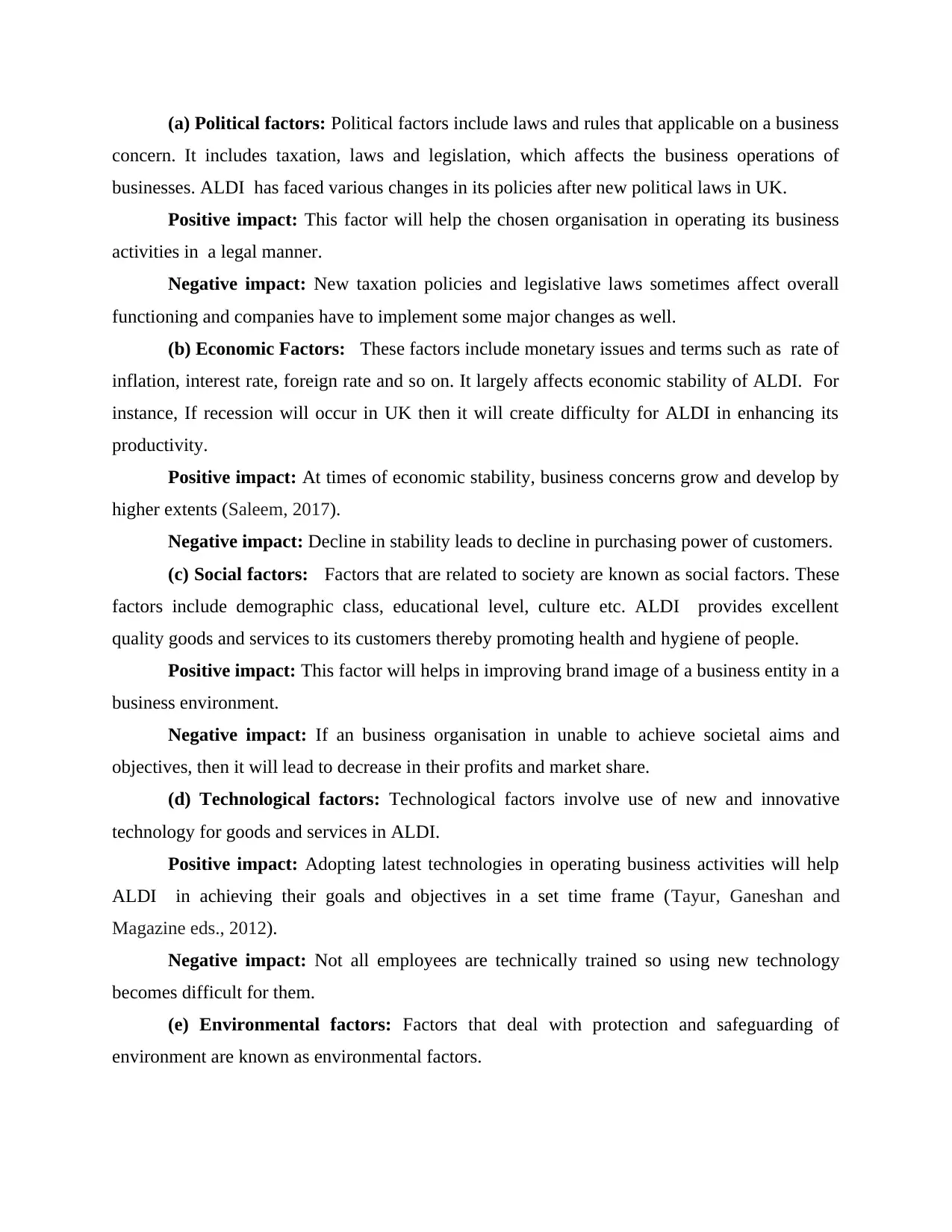
(a) Political factors: Political factors include laws and rules that applicable on a business
concern. It includes taxation, laws and legislation, which affects the business operations of
businesses. ALDI has faced various changes in its policies after new political laws in UK.
Positive impact: This factor will help the chosen organisation in operating its business
activities in a legal manner.
Negative impact: New taxation policies and legislative laws sometimes affect overall
functioning and companies have to implement some major changes as well.
(b) Economic Factors: These factors include monetary issues and terms such as rate of
inflation, interest rate, foreign rate and so on. It largely affects economic stability of ALDI. For
instance, If recession will occur in UK then it will create difficulty for ALDI in enhancing its
productivity.
Positive impact: At times of economic stability, business concerns grow and develop by
higher extents (Saleem, 2017).
Negative impact: Decline in stability leads to decline in purchasing power of customers.
(c) Social factors: Factors that are related to society are known as social factors. These
factors include demographic class, educational level, culture etc. ALDI provides excellent
quality goods and services to its customers thereby promoting health and hygiene of people.
Positive impact: This factor will helps in improving brand image of a business entity in a
business environment.
Negative impact: If an business organisation in unable to achieve societal aims and
objectives, then it will lead to decrease in their profits and market share.
(d) Technological factors: Technological factors involve use of new and innovative
technology for goods and services in ALDI.
Positive impact: Adopting latest technologies in operating business activities will help
ALDI in achieving their goals and objectives in a set time frame (Tayur, Ganeshan and
Magazine eds., 2012).
Negative impact: Not all employees are technically trained so using new technology
becomes difficult for them.
(e) Environmental factors: Factors that deal with protection and safeguarding of
environment are known as environmental factors.
concern. It includes taxation, laws and legislation, which affects the business operations of
businesses. ALDI has faced various changes in its policies after new political laws in UK.
Positive impact: This factor will help the chosen organisation in operating its business
activities in a legal manner.
Negative impact: New taxation policies and legislative laws sometimes affect overall
functioning and companies have to implement some major changes as well.
(b) Economic Factors: These factors include monetary issues and terms such as rate of
inflation, interest rate, foreign rate and so on. It largely affects economic stability of ALDI. For
instance, If recession will occur in UK then it will create difficulty for ALDI in enhancing its
productivity.
Positive impact: At times of economic stability, business concerns grow and develop by
higher extents (Saleem, 2017).
Negative impact: Decline in stability leads to decline in purchasing power of customers.
(c) Social factors: Factors that are related to society are known as social factors. These
factors include demographic class, educational level, culture etc. ALDI provides excellent
quality goods and services to its customers thereby promoting health and hygiene of people.
Positive impact: This factor will helps in improving brand image of a business entity in a
business environment.
Negative impact: If an business organisation in unable to achieve societal aims and
objectives, then it will lead to decrease in their profits and market share.
(d) Technological factors: Technological factors involve use of new and innovative
technology for goods and services in ALDI.
Positive impact: Adopting latest technologies in operating business activities will help
ALDI in achieving their goals and objectives in a set time frame (Tayur, Ganeshan and
Magazine eds., 2012).
Negative impact: Not all employees are technically trained so using new technology
becomes difficult for them.
(e) Environmental factors: Factors that deal with protection and safeguarding of
environment are known as environmental factors.
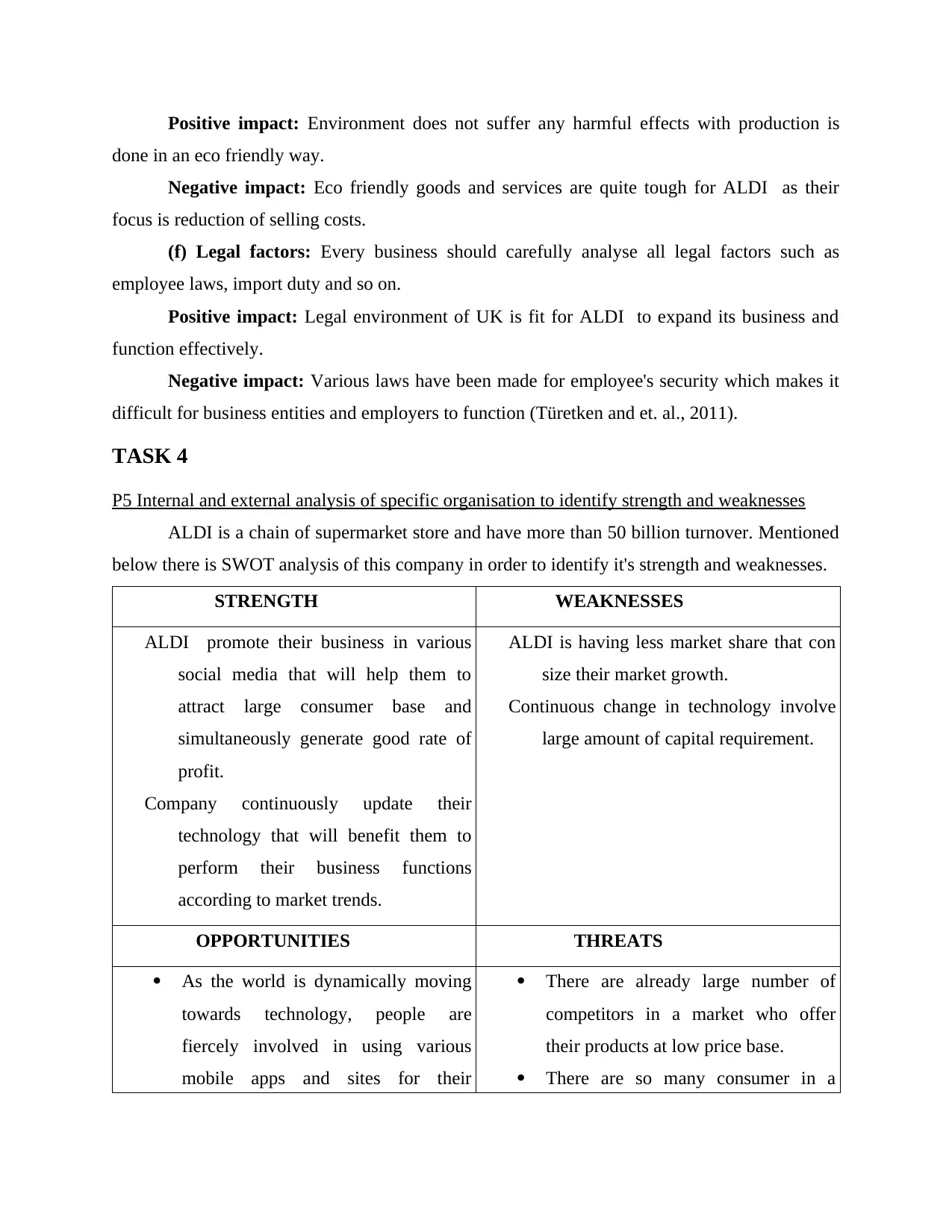
Positive impact: Environment does not suffer any harmful effects with production is
done in an eco friendly way.
Negative impact: Eco friendly goods and services are quite tough for ALDI as their
focus is reduction of selling costs.
(f) Legal factors: Every business should carefully analyse all legal factors such as
employee laws, import duty and so on.
Positive impact: Legal environment of UK is fit for ALDI to expand its business and
function effectively.
Negative impact: Various laws have been made for employee's security which makes it
difficult for business entities and employers to function (Türetken and et. al., 2011).
TASK 4
P5 Internal and external analysis of specific organisation to identify strength and weaknesses
ALDI is a chain of supermarket store and have more than 50 billion turnover. Mentioned
below there is SWOT analysis of this company in order to identify it's strength and weaknesses.
STRENGTH WEAKNESSES
ALDI promote their business in various
social media that will help them to
attract large consumer base and
simultaneously generate good rate of
profit.
Company continuously update their
technology that will benefit them to
perform their business functions
according to market trends.
ALDI is having less market share that con
size their market growth.
Continuous change in technology involve
large amount of capital requirement.
OPPORTUNITIES THREATS
As the world is dynamically moving
towards technology, people are
fiercely involved in using various
mobile apps and sites for their
There are already large number of
competitors in a market who offer
their products at low price base.
There are so many consumer in a
done in an eco friendly way.
Negative impact: Eco friendly goods and services are quite tough for ALDI as their
focus is reduction of selling costs.
(f) Legal factors: Every business should carefully analyse all legal factors such as
employee laws, import duty and so on.
Positive impact: Legal environment of UK is fit for ALDI to expand its business and
function effectively.
Negative impact: Various laws have been made for employee's security which makes it
difficult for business entities and employers to function (Türetken and et. al., 2011).
TASK 4
P5 Internal and external analysis of specific organisation to identify strength and weaknesses
ALDI is a chain of supermarket store and have more than 50 billion turnover. Mentioned
below there is SWOT analysis of this company in order to identify it's strength and weaknesses.
STRENGTH WEAKNESSES
ALDI promote their business in various
social media that will help them to
attract large consumer base and
simultaneously generate good rate of
profit.
Company continuously update their
technology that will benefit them to
perform their business functions
according to market trends.
ALDI is having less market share that con
size their market growth.
Continuous change in technology involve
large amount of capital requirement.
OPPORTUNITIES THREATS
As the world is dynamically moving
towards technology, people are
fiercely involved in using various
mobile apps and sites for their
There are already large number of
competitors in a market who offer
their products at low price base.
There are so many consumer in a
⊘ This is a preview!⊘
Do you want full access?
Subscribe today to unlock all pages.

Trusted by 1+ million students worldwide
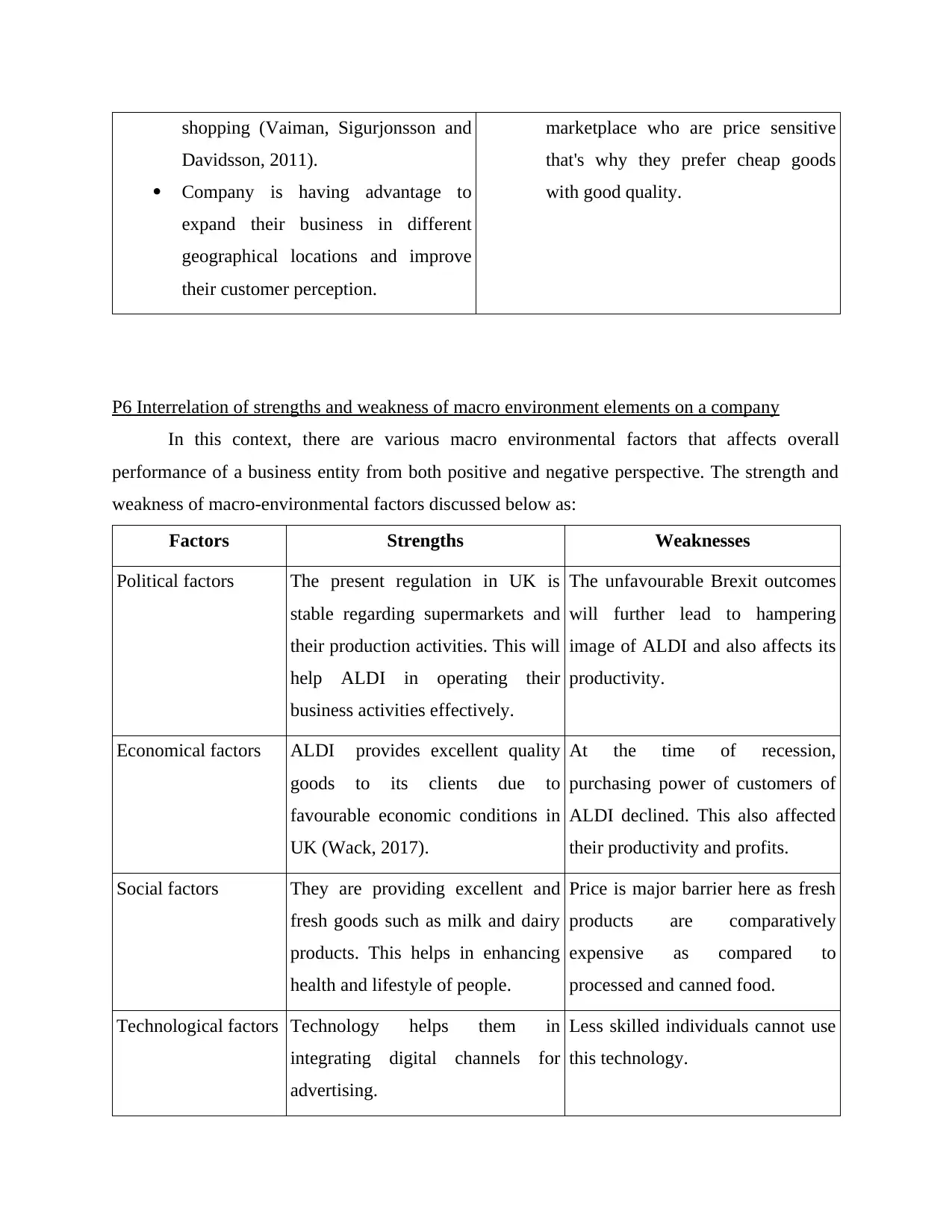
shopping (Vaiman, Sigurjonsson and
Davidsson, 2011).
Company is having advantage to
expand their business in different
geographical locations and improve
their customer perception.
marketplace who are price sensitive
that's why they prefer cheap goods
with good quality.
P6 Interrelation of strengths and weakness of macro environment elements on a company
In this context, there are various macro environmental factors that affects overall
performance of a business entity from both positive and negative perspective. The strength and
weakness of macro-environmental factors discussed below as:
Factors Strengths Weaknesses
Political factors The present regulation in UK is
stable regarding supermarkets and
their production activities. This will
help ALDI in operating their
business activities effectively.
The unfavourable Brexit outcomes
will further lead to hampering
image of ALDI and also affects its
productivity.
Economical factors ALDI provides excellent quality
goods to its clients due to
favourable economic conditions in
UK (Wack, 2017).
At the time of recession,
purchasing power of customers of
ALDI declined. This also affected
their productivity and profits.
Social factors They are providing excellent and
fresh goods such as milk and dairy
products. This helps in enhancing
health and lifestyle of people.
Price is major barrier here as fresh
products are comparatively
expensive as compared to
processed and canned food.
Technological factors Technology helps them in
integrating digital channels for
advertising.
Less skilled individuals cannot use
this technology.
Davidsson, 2011).
Company is having advantage to
expand their business in different
geographical locations and improve
their customer perception.
marketplace who are price sensitive
that's why they prefer cheap goods
with good quality.
P6 Interrelation of strengths and weakness of macro environment elements on a company
In this context, there are various macro environmental factors that affects overall
performance of a business entity from both positive and negative perspective. The strength and
weakness of macro-environmental factors discussed below as:
Factors Strengths Weaknesses
Political factors The present regulation in UK is
stable regarding supermarkets and
their production activities. This will
help ALDI in operating their
business activities effectively.
The unfavourable Brexit outcomes
will further lead to hampering
image of ALDI and also affects its
productivity.
Economical factors ALDI provides excellent quality
goods to its clients due to
favourable economic conditions in
UK (Wack, 2017).
At the time of recession,
purchasing power of customers of
ALDI declined. This also affected
their productivity and profits.
Social factors They are providing excellent and
fresh goods such as milk and dairy
products. This helps in enhancing
health and lifestyle of people.
Price is major barrier here as fresh
products are comparatively
expensive as compared to
processed and canned food.
Technological factors Technology helps them in
integrating digital channels for
advertising.
Less skilled individuals cannot use
this technology.
Paraphrase This Document
Need a fresh take? Get an instant paraphrase of this document with our AI Paraphraser
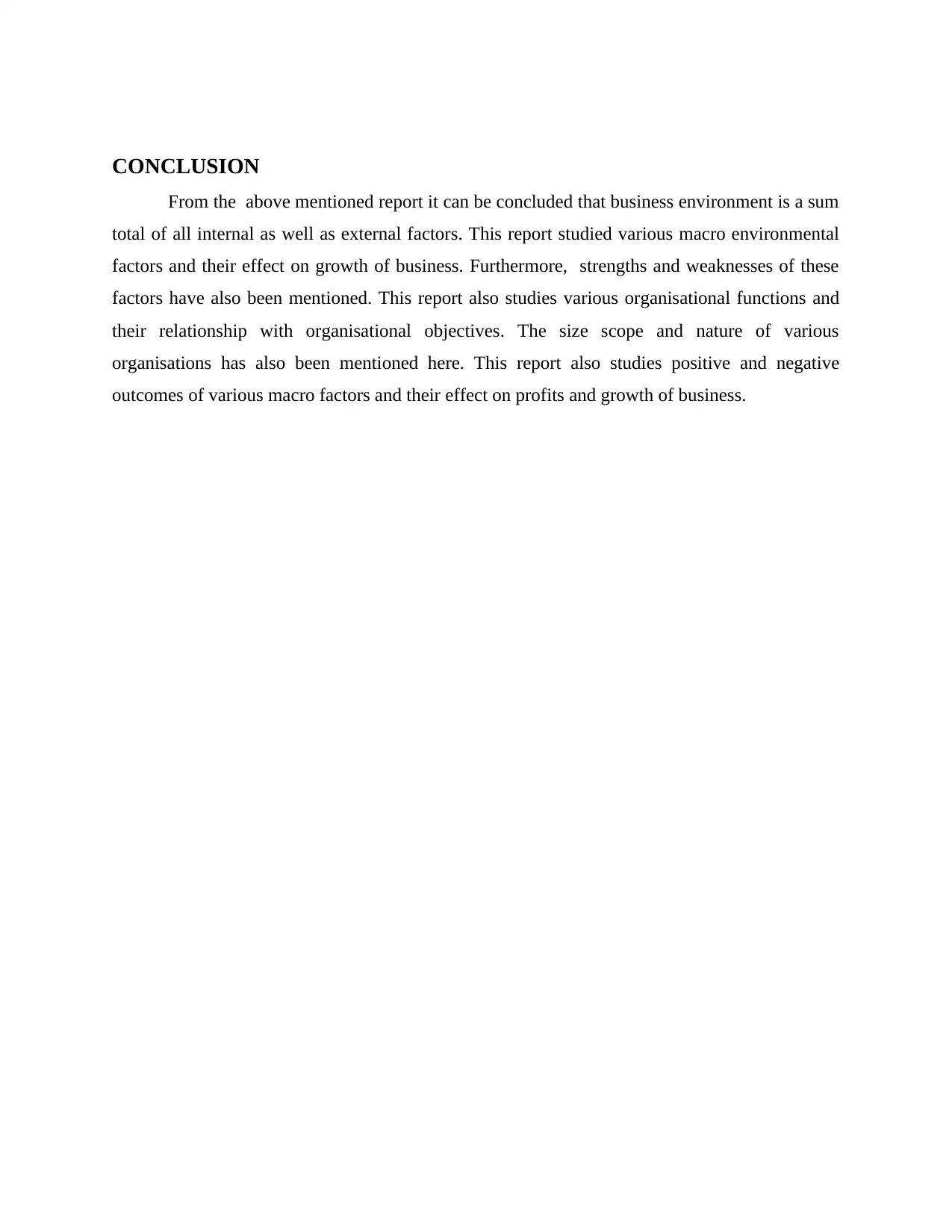
CONCLUSION
From the above mentioned report it can be concluded that business environment is a sum
total of all internal as well as external factors. This report studied various macro environmental
factors and their effect on growth of business. Furthermore, strengths and weaknesses of these
factors have also been mentioned. This report also studies various organisational functions and
their relationship with organisational objectives. The size scope and nature of various
organisations has also been mentioned here. This report also studies positive and negative
outcomes of various macro factors and their effect on profits and growth of business.
From the above mentioned report it can be concluded that business environment is a sum
total of all internal as well as external factors. This report studied various macro environmental
factors and their effect on growth of business. Furthermore, strengths and weaknesses of these
factors have also been mentioned. This report also studies various organisational functions and
their relationship with organisational objectives. The size scope and nature of various
organisations has also been mentioned here. This report also studies positive and negative
outcomes of various macro factors and their effect on profits and growth of business.
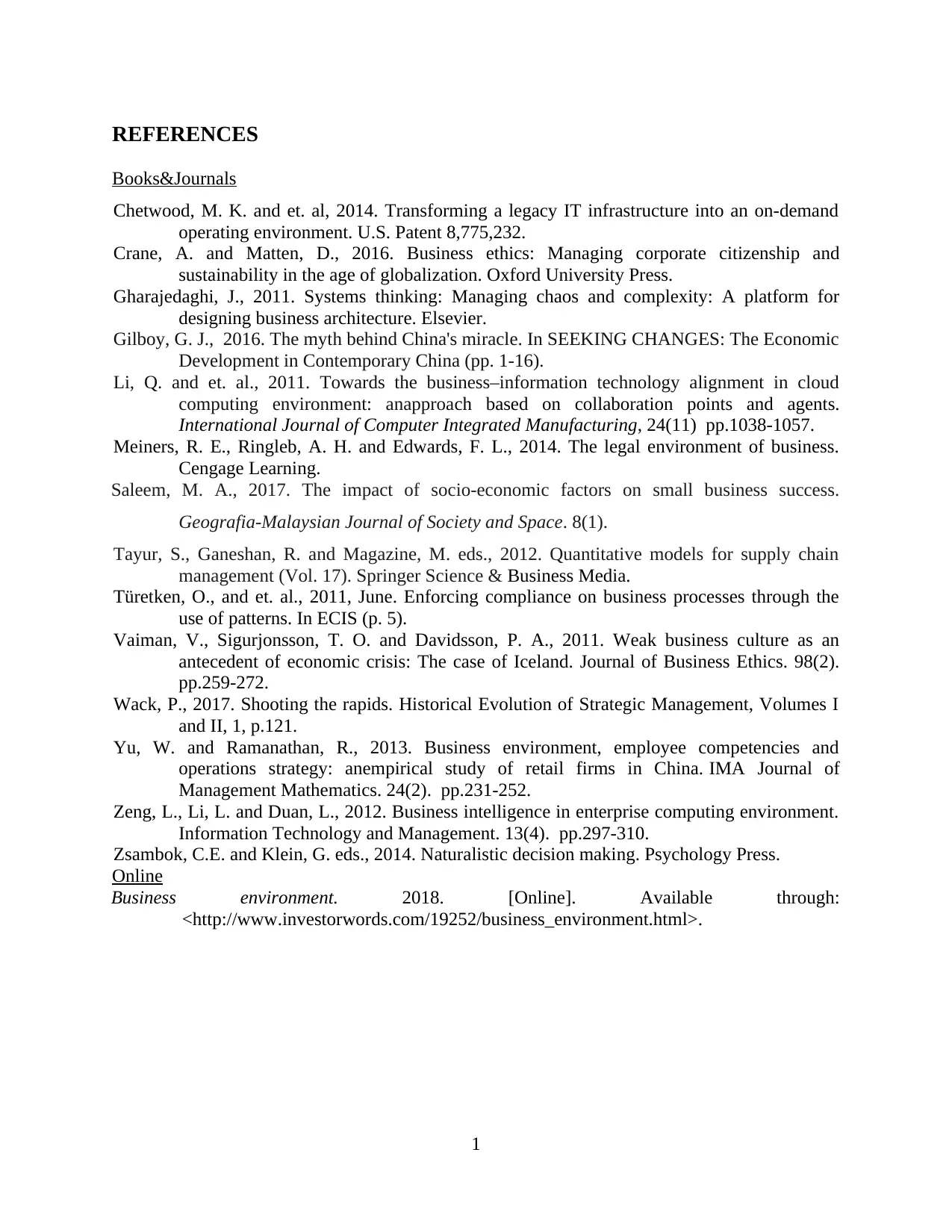
REFERENCES
Books&Journals
Chetwood, M. K. and et. al, 2014. Transforming a legacy IT infrastructure into an on-demand
operating environment. U.S. Patent 8,775,232.
Crane, A. and Matten, D., 2016. Business ethics: Managing corporate citizenship and
sustainability in the age of globalization. Oxford University Press.
Gharajedaghi, J., 2011. Systems thinking: Managing chaos and complexity: A platform for
designing business architecture. Elsevier.
Gilboy, G. J., 2016. The myth behind China's miracle. In SEEKING CHANGES: The Economic
Development in Contemporary China (pp. 1-16).
Li, Q. and et. al., 2011. Towards the business–information technology alignment in cloud
computing environment: anapproach based on collaboration points and agents.
International Journal of Computer Integrated Manufacturing, 24(11) pp.1038-1057.
Meiners, R. E., Ringleb, A. H. and Edwards, F. L., 2014. The legal environment of business.
Cengage Learning.
Saleem, M. A., 2017. The impact of socio-economic factors on small business success.
Geografia-Malaysian Journal of Society and Space. 8(1).
Tayur, S., Ganeshan, R. and Magazine, M. eds., 2012. Quantitative models for supply chain
management (Vol. 17). Springer Science & Business Media.
Türetken, O., and et. al., 2011, June. Enforcing compliance on business processes through the
use of patterns. In ECIS (p. 5).
Vaiman, V., Sigurjonsson, T. O. and Davidsson, P. A., 2011. Weak business culture as an
antecedent of economic crisis: The case of Iceland. Journal of Business Ethics. 98(2).
pp.259-272.
Wack, P., 2017. Shooting the rapids. Historical Evolution of Strategic Management, Volumes I
and II, 1, p.121.
Yu, W. and Ramanathan, R., 2013. Business environment, employee competencies and
operations strategy: anempirical study of retail firms in China. IMA Journal of
Management Mathematics. 24(2). pp.231-252.
Zeng, L., Li, L. and Duan, L., 2012. Business intelligence in enterprise computing environment.
Information Technology and Management. 13(4). pp.297-310.
Zsambok, C.E. and Klein, G. eds., 2014. Naturalistic decision making. Psychology Press.
Online
Business environment. 2018. [Online]. Available through:
<http://www.investorwords.com/19252/business_environment.html>.
1
Books&Journals
Chetwood, M. K. and et. al, 2014. Transforming a legacy IT infrastructure into an on-demand
operating environment. U.S. Patent 8,775,232.
Crane, A. and Matten, D., 2016. Business ethics: Managing corporate citizenship and
sustainability in the age of globalization. Oxford University Press.
Gharajedaghi, J., 2011. Systems thinking: Managing chaos and complexity: A platform for
designing business architecture. Elsevier.
Gilboy, G. J., 2016. The myth behind China's miracle. In SEEKING CHANGES: The Economic
Development in Contemporary China (pp. 1-16).
Li, Q. and et. al., 2011. Towards the business–information technology alignment in cloud
computing environment: anapproach based on collaboration points and agents.
International Journal of Computer Integrated Manufacturing, 24(11) pp.1038-1057.
Meiners, R. E., Ringleb, A. H. and Edwards, F. L., 2014. The legal environment of business.
Cengage Learning.
Saleem, M. A., 2017. The impact of socio-economic factors on small business success.
Geografia-Malaysian Journal of Society and Space. 8(1).
Tayur, S., Ganeshan, R. and Magazine, M. eds., 2012. Quantitative models for supply chain
management (Vol. 17). Springer Science & Business Media.
Türetken, O., and et. al., 2011, June. Enforcing compliance on business processes through the
use of patterns. In ECIS (p. 5).
Vaiman, V., Sigurjonsson, T. O. and Davidsson, P. A., 2011. Weak business culture as an
antecedent of economic crisis: The case of Iceland. Journal of Business Ethics. 98(2).
pp.259-272.
Wack, P., 2017. Shooting the rapids. Historical Evolution of Strategic Management, Volumes I
and II, 1, p.121.
Yu, W. and Ramanathan, R., 2013. Business environment, employee competencies and
operations strategy: anempirical study of retail firms in China. IMA Journal of
Management Mathematics. 24(2). pp.231-252.
Zeng, L., Li, L. and Duan, L., 2012. Business intelligence in enterprise computing environment.
Information Technology and Management. 13(4). pp.297-310.
Zsambok, C.E. and Klein, G. eds., 2014. Naturalistic decision making. Psychology Press.
Online
Business environment. 2018. [Online]. Available through:
<http://www.investorwords.com/19252/business_environment.html>.
1
⊘ This is a preview!⊘
Do you want full access?
Subscribe today to unlock all pages.

Trusted by 1+ million students worldwide
1 out of 14
Related Documents
Your All-in-One AI-Powered Toolkit for Academic Success.
+13062052269
info@desklib.com
Available 24*7 on WhatsApp / Email
![[object Object]](/_next/static/media/star-bottom.7253800d.svg)
Unlock your academic potential
Copyright © 2020–2025 A2Z Services. All Rights Reserved. Developed and managed by ZUCOL.





